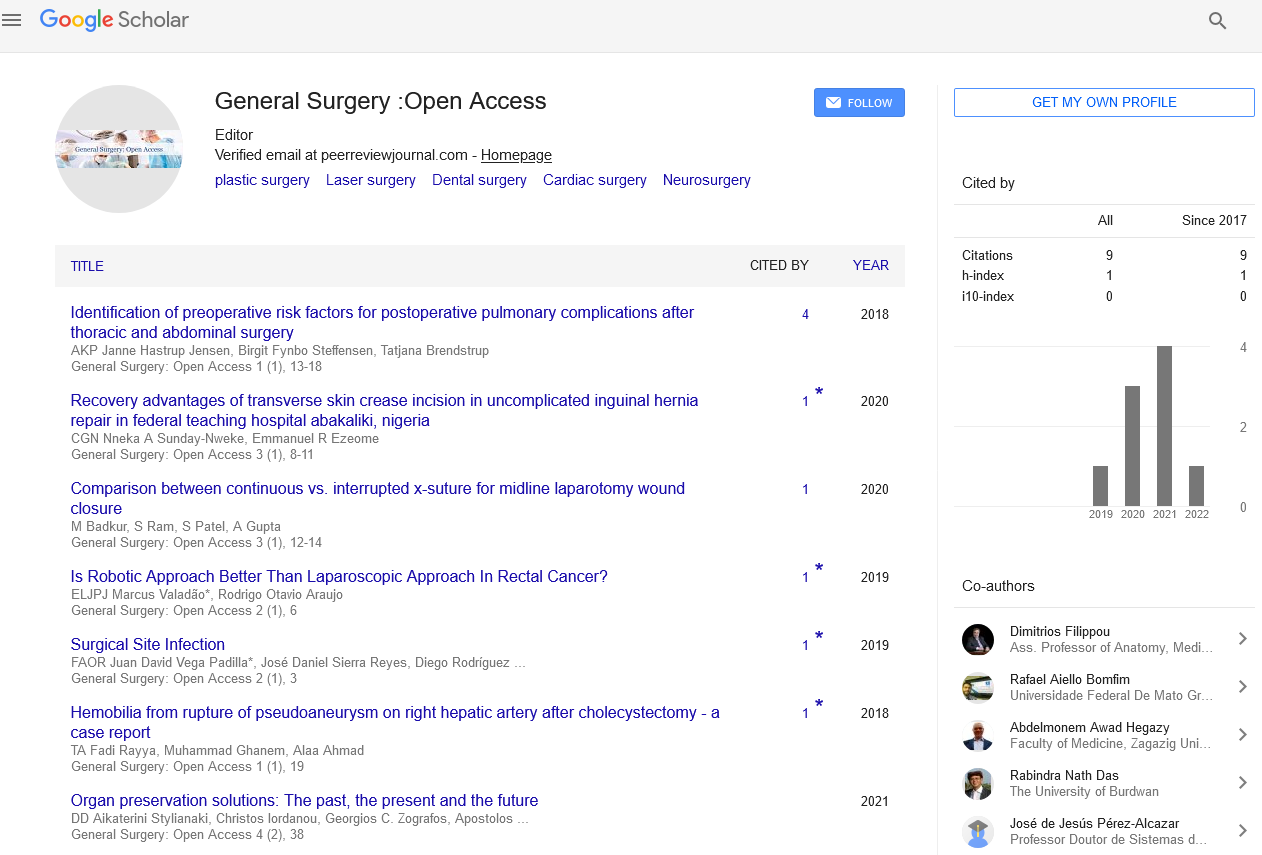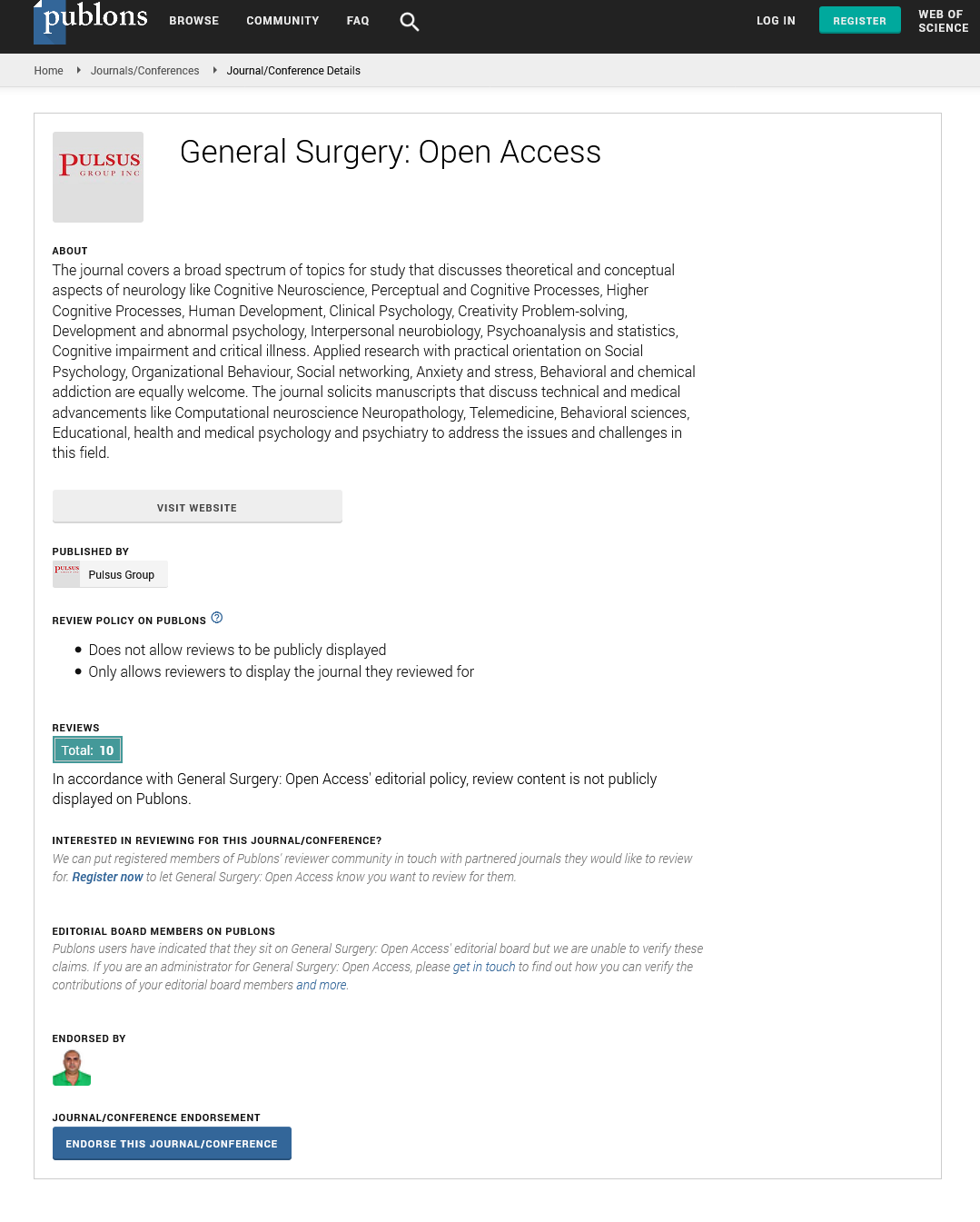Pectoral nerve blocks for breast surgery
Received: 05-May-2021 Accepted Date: May 19, 2021; Published: 26-May-2021, DOI: 10.37532/pulgsoa.2021.4(3).14
Citation: Gameraddin M. Pectoral nerve blocks for breast surgery. Gen surg: Open Access. 2021;4(3):14.
This open-access article is distributed under the terms of the Creative Commons Attribution Non-Commercial License (CC BY-NC) (http://creativecommons.org/licenses/by-nc/4.0/), which permits reuse, distribution and reproduction of the article, provided that the original work is properly cited and the reuse is restricted to noncommercial purposes. For commercial reuse, contact reprints@pulsus.com
Description
The pectoral nerve block I and II are a novel strategy to impede the pectoral nerves, intercostal nerves 3 to 6, intercostobrachial nerves, and the long thoracic nerves. The procedure is easy to perform, and the clinician can perform it with practically no sedation in the pre-usable holding territory. This action traces Pecs block I and II and features the job of the medical care group in improving consideration for patients going through an assortment of foremost chest divider medical procedures, most generally bosom a medical procedure.
Pectoralis nerve (Pecs) and serratus plane nerve blocks are more up to date ultrasound (US)- guided territorial sedation methods of the chest. The expanding utilization of ultrasonography to recognize tissue layers and, especially, fascial layers has prompted the advancement of a few more current interfascial infusion strategies for absense of pain of the chest and stomach divider. For example, the Pecs I nerve block was formulated to anesthetize the average and sidelong pectoral nerves, which innervate the pectoralis muscles.
This is refined by an infusion of nearby sedative in the fascial plane between the pectoralis major and minor muscles. The Pecs II nerve block (which likewise incorporates the Pecs I nerve block) is an augmentation that includes a second infusion sidelong to the Pecs I infusion point in the plane between the pectoralis minor and serratus foremost muscles fully intent on giving bar of the upper intercostal nerves. A further alteration is the serratus plane nerve block, in which nearby sedative is infused between the serratus foremost and latissimus dorsi muscles.
These interfascial infusions were created as options in contrast to thoracic epidural, paravertebral, intercostal, and intrapleural nerve blocks, basically for absense of pain after a medical procedure on the hemithorax. At first, Pecs nerve blocks were planned for absense of pain after bosom a medical procedure; in any case, case reports have likewise depicted the utilization of Pecs and serratus plane nerve blocks for absense of pain following thoracotomy and rib crack.
The axillary district is sidelong to the pectoral locale and comprises of the space of the upper chest that encompasses the axilla. In the two areas, there are muscles, nerves, and vessels inside the fascial layers . In the pectoral locale, there are four muscles applicable to Pecs nerve hinders: the pectoralis major, pectoralis minor, serratus front, and subclavius muscles. The pectoralis major and minor muscles are innervated by the parallel and average pectoral nerves; the serratus front is innervated by the long thoracic nerve (C5, C6, and C7); and the subclavius is innervated then by the upper trunk of the brachial plexus (C5 and C6).
The pectoral and axillary locales are isolated by belts. In the pectoral area, there are two primary belts: the shallow sash and the profound thoracic belt.
The profound thoracic belt partitions into three separate sashes: the pectoral (shallow), clavipectoral (middle), and exothoracic (profound). The clavipectoral sash extends between the clavicle and the pectoralis minor and encases the pectoralis minor with a slight layer of belt. Between the pectoralis minor and subclavius muscles, the two layers of the clavipectoral sash combine.
The initial two compartments are in the pectoral district, yet the third and fourth speak with the axillary locale. The nerves and vessels in this district make correspondences by intersection the compartments. The nerves of the pectoral area are mostly the sidelong and average pectoral nerves, yet there is likewise a significant innervation from the supraclavicular nerve and from the parallel and front parts of the intercostal nerves. The horizontal pectoral nerve crosses the axillary course anteriorly and penetrates the clavipectoral belt in cozy relationship with the thoracoacromial vein on the undersurface of the upper bit of the pectoralis significant muscle, which it supplies with parallel line filaments. The sidelong pectoral nerve is average to the pectoralis minor prior to entering the pectoralis significant muscle; it conveys across the axillary vein with the average pectoral nerve and, through this correspondence (by means of ansa pectoralis), supplies the pectoralis minor. The average pectoral nerve emerges from the average rope filaments from C8 T1, behind the axillary vein at the level underneath the clavicle, and goes through the profound surface of the pectoralis minor, which is punctured and afterward enters and innervates pectoralis major. Both pectoral nerves enter the profound surface of the pectoralis major, and neither has a cutaneous branch. The nerves of the axillary district are the intercostobrachial, intercostal T3 T9, long thoracic, and thoracodorsal. The intercostobrachial nerve is the horizontal cutaneous part of the second and third intercostal nerves in 67% and 33% of cases, individually. It crosses the serratus foremost muscle in the midaxillary line to innervate the axilla. The intercostobrachial nerve is an indispensable nerve if local sedation of the axilla is required.
The intercostal nerves (T3-T9) give engine supply to the intercostal muscles and get tactile data from the skin and parietal pleura. The intercostal nerves have back, sidelong, and front branches and a foremost adornment branch that innervates the sternum. The horizontal branches innervate the vast majority of the pectoral and axillary locales, along with the back hemithorax, back to the scapula. They puncture the outside intercostal muscle and exit between the serratus foremost digitations at the level of the midaxillary line. The long thoracic nerve is in the axillary compartment near the parallel thoracic part of the thoracoacromial vein and goes down the horizontal part of the serratus front muscle, which it innervates.






